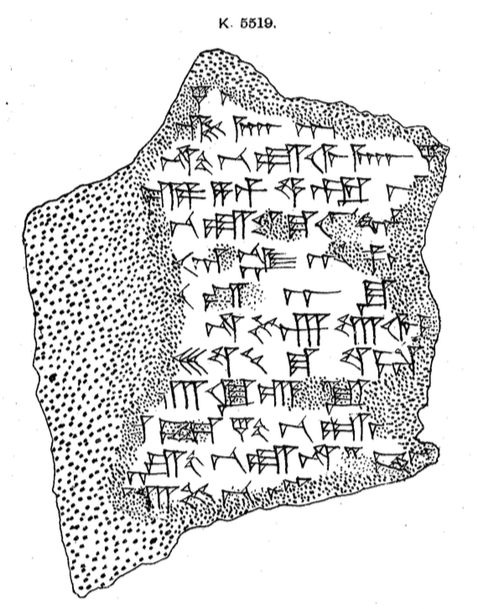Izre’el: Origins of the Adapa Myth
by Estéban Trujillo de Gutiérrez
“Adapa the Sage
Adapa was known in Ancient Mesopotamia as The Sage. The original etymology of the name Adapa may not have reached us. A lexical text lists a term adapu as meaning “wise” (Igituh I: 107), an attribute that is further attested in another late text (Lambert 1962: 74). This adjectival noun is undoubtedly derived from the name of the mythological figure Adapa (CAD A/I 102 s.v. adapu B; AHw 1542 s.v. adapu III).
This lexical text has ù.tu.a.ab.ba “born in the sea” as the Sumerian equivalent of adapu, an equation that may have resulted from folk etymology (Lambert 1962: 73-4). In any case, whether primary or secondary, this possible etymology shows the mythological characteristics attributed to Adapa by the Mesopotamians, since he, as one of the first antediluvian sages, was thought to have emerged from the sea.
At some point, the name Adapa was interpreted as an epithet rather than as a proper noun, and as such it co-occurs with the name Uan(na), “the light of An” (see below).
Whether the word was originally an epithet or a name is hard to tell, especially since one cannot draw any sound conclusions regarding the origin of the myth or of any individual mytheme from the chronology of its occasional textual finds.

K 5519, British Museum.
E.A. Wallis Budge, ed., Cuneiform Texts from Babylonian Tablets in the British Museum, part XXX, British Museum, London, 1911. Plate 8.
http://www.etana.org/sites/default/files/coretexts/17079.pdf
In a Sumero-Akkadian bilingual account of the first sages, a priest of Eridu is mentioned as one who ascended to heaven:
“[PN,] the purification priest of Eridu
[. . .] who ascended to heaven.
They are the seven brilliant apkallus, purãdu-fish of the sea,
[sev]en apkallus “grown” in the river,
who insure the correct functioning of the ordinance of heaven and earth.”
(K 5519: I’ – 9’ after Reiner 1961: 2, 4).
Reiner (1961: 6-7) suggested that the subject here was Adapa. However, taken in its context as part of the bīt mēseri ritual, the name of the apkallu mentioned is Utuabzu (“born in the Apsu”), who comes seventh in a list of apkallus (Borger 1974: 192-4).

A fish-apkallu drawn by A.H. Layard from a stone relief, one of a pair flanking a doorway in the Temple of Ninurta at Kalhu.
This example is identical to illustration 55 in Dalley’s article on the apkallu, which she cites for the dual daggers in his waistband.
British Museum.
Reproduced in Schlomo Izre’el, Adapa and the South Wind: Language Has the Power of Life and Death, Eisenbrauns, 2001.
https://books.google.co.th/books?id=MbwwROVGl7UC&pg=PA3&source=gbs_selected_pages&cad=3#v=onepage&q&f=false
In another place in the same text, the last of seven sages is Utua-abba, mentioned as one who descended from heaven (Borger 1974: 193-4; see also Borger 1994: 231 and p. 232 n. 37).
The name Uan is listed as the first apkallu, who served during the time of the king Ayyalu (van Dijk 1962: 44). It is he who is mentioned as the one who “completed the ordinance of heaven and earth.”
The Greek variant of the name Uan, namely Oannes, is known from the account of Babylonian history by Berossus, The Babyloniaca, where it is said that before civilization was introduced to the people of Mesopotamia,
“…there was a great crowd of men in Babylonia and they lived without laws as wild animals. In the first year (i.e., of the reign of Alorus) a beast named Oannes appeared from the Erythrean Sea in a place adjacent to Babylonia. Its entire body was that of a fish, but a human head had grown beneath the head of the fish and human feet likewise had grown from the fish’s tail. It also had a human voice. A picture of it is still preserved today.”
(Burstein 1978: 13-4).
The evidence in our possession thus seems to point to at least two different original traditions (cf. Wiggermann 1986: 153) that have become a single unified tradition in the most prominent remaining texts (cf. the remarks by Denning-Bolle 1992: 44-5).
I believe that in the myth of Adapa and the South Wind, as it was interpreted in the traditions that have reached us, there is a strong case for such a unified tradition. Variation, it must be noted, is a part of the very nature of mythological traditions (cf. pp. 108-10 below).”
Schlomo Izre’el, Adapa and the South Wind: Language Has the Power of Life and Death, Eisenbrauns, 2001, pp. 1-2.

[…] Izre’el: Origins of the Adapa Myth. […]
LikeLike